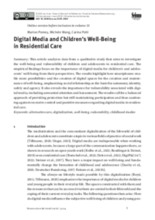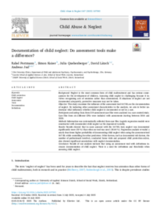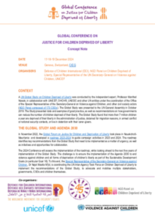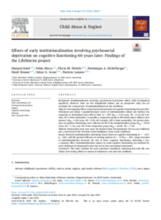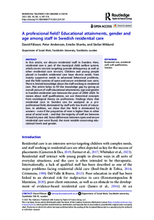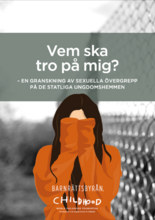Displaying 1 - 10 of 55
This study examines how children in Swiss residential care perceive safety, revealing that while institutions aim to protect them, many still experience both safety and unsafety shaped by physical spaces, institutional rules, and relationships with staff. By centering children’s voices, the article highlights gaps between residential care’s protective mandate and children’s lived experiences, calling for a more nuanced, justice-oriented understanding of safety in child welfare.
This article analyzes data from a qualitative study that aims to investigate the well-being and vulnerability of Swiss children and adolescents in residential care. The empirical findings focus on the importance of digital media for children’s and adolescents’ well-being from their perspectives.
Neglect is the most common form of child maltreatment and has serious consequences for the development of children. Assessing child neglect is challenging because it involves recognizing acts of omission rather than commissions. This study examines the influence of the assessment tool SAT-BL on the documentation of neglect.
The Conference is designed as a two-day event, targeting key groups such as administration of justice, children deprived of liberty and professionals who work with them, children on the move, children in institutions and children detained in the context of armed conflict.
The purpose of this longitudinal study conducted on institutionalized infants and toddlers in Switzerland from 1958 to 1961 and then 60 years later on the same group, is to investigate the effects of psychosocial deprivation on cognitive functioning in late adulthood.
This study aimed to investigate developmental outcomes of children raised in institutions in Switzerland in conditions of psychosocial deprivation and to identify possible risk and protective factors at institutional and child levels.
This essay examines how child abuse and violence that occurred in the past have been conceptualised in one current redress process in an established democracy – the Swedish redress initiatives for historical abuse of children in out-of-home care.
In this article, the authors discuss residential staff in Sweden where residential care is part of the municipal child welfare system, which covers services targeting juvenile delinquency as well as other residential care services. Children and young people placed in Swedish residential care have diverse needs, from mainly supportive needs to advanced behavioral problems, and the field consists of open and secure residential care units.
This paper is a first approach to pursuing questions of subjectification and objectification in the context of children and youth growing up in care settings in Switzerland.
Rapporten visar på omfattande sexuella övergrepp och kränkningar mot barn på svenska statliga ungdomshem – platser som är avsedda att vara trygga för unga med omfattande psykosocial problematik. Kunskapen om att barn utsätts för sexuella övergrepp på SiS har funnits länge. Bara förra året kom granskningar från Institutionen för vård och omsorg (IVO), Justitieombudsmannen (JO) och Statskontoret som alla visade på stora brister inklusive våld och sexuella övergrepp.


